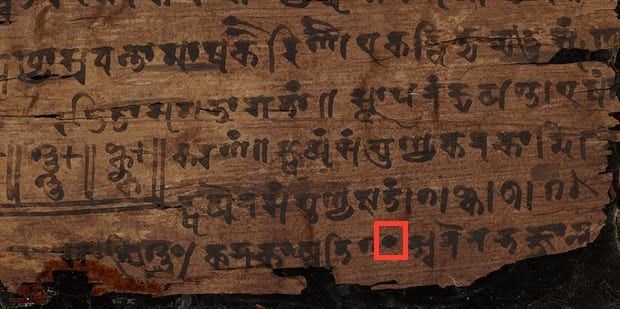First Zero Ever Written? Scientists Argue Over Ancient Indian Math Symbols

Researchers are challenging a claim that an ancient Indian mathematical document contains the oldest recorded use of a zero.
The Bodleian Libraries at Oxford University announced last month that experts recently dated the Bakhshali manuscript to as early as 200 BCE and, because it is full of symbols that signify the number zero, said it represents the earliest known use of that number. The next recorded use occurred about 500 years after the alleged date of the manuscript. But a group of historians specializing in Indian mathematics are challenging this discovery. According to a statement from the University of Alberta, the calculations would have been written much later than asserted.
The difference in interpretation stems from the material from which the manuscript is made: dozens of birch bark leaves collected in different eras. While the scientists at Oxford made their announcement about finding the earliest zero after radiocarbon-dating the oldest parts of the document to between 1,600 and 1,800 years ago, other leaves came from more recent centuries.
A leaf from the Bakhshali Manuscript, showing off Indian mathematical genius. A zero symbol has been highlighted in the second image. pic.twitter.com/65iZpEVkld
— Bodleian Libraries (@bodleianlibs) September 14, 2017
The math historians are arguing that because the calculations are cohesive writings, the zeroes must have been jotted down after the last leaf was set into place, making them centuries younger than the Oxford researchers are suggesting.
“The treatise shows no signs of being a jumble of fragments from different periods,” the university said. “Both the handwriting and the topic being discussed are continuous across the boundary of the first two dated leaves. It looks very much as if the scribe, who may have lived at the end of the eighth century, wrote out his treatise on a group of leaves that had been manufactured at very different times.”
If the critics of the Bakhshali manuscript’s analysis are right, the earliest confirmed recorded use of the number zero would still be a ninth-century inscription on a temple wall in Gwalior, India.
Although ancient civilizations had previously come up with the concept of nothingness, it took a while for that to translate to mathematics. When people started using zero as a number in calculations, it was a turning point in the discipline.
The Bakhshali manuscript was found in the late 1800s in what is now Pakistan. According to researchers, it contains numerous dots that are supposed to represent zeroes, placeholders in a series of calculations. “It was used to indicate orders of magnitude in a number system — for example, denoting 10s, 100s and 1000s,” the libraries explained last month.
Eventually that dot transformed into the ring symbol we use as a zero today.
“This isn’t some sort of theoretical text, it seems to be a practical document that is being used by merchants to do calculations,” mathematics professor Marcus du Sautoy said about the Bakhshali manuscript in a video. He referred to the first use of zero as a time when “mathematicians in India planted the seed of the idea that would later become so fundamental to the modern world. … The findings show how vibrant mathematics have been in the Indian subcontinent for centuries.”
Although the math historians are dissenting on the age of the zeroes in the Bakhshali manuscript, they say the number contains more significance in the document than Oxford gave it credit for.
“The Bakhshali treatise does indeed know the ‘true’ zero, and contains calculations like long multiplication that would have necessitated using zero as an arithmetical number” rather than just a placeholder, the University of Alberta said. “Furthermore, the treatise even contains a statement saying, ‘having added one to zero,’ thus proving that the early Sanskrit author was thinking about zero in a numerical way.”
© Copyright IBTimes 2024. All rights reserved.




















